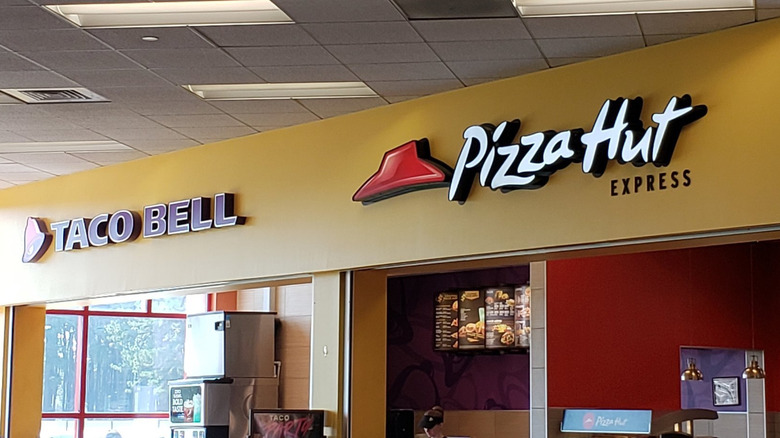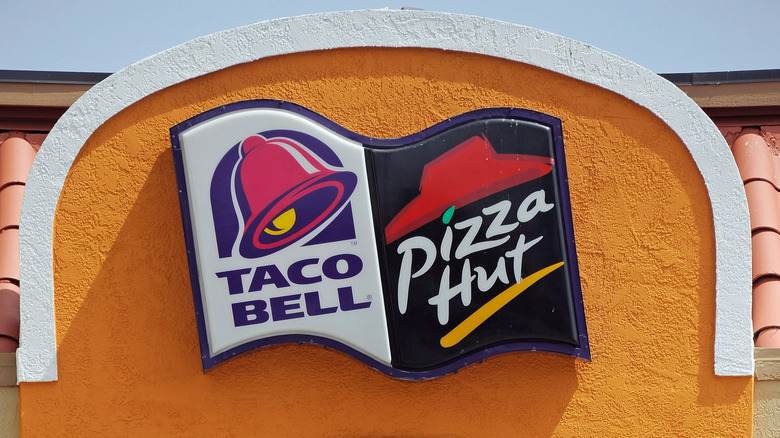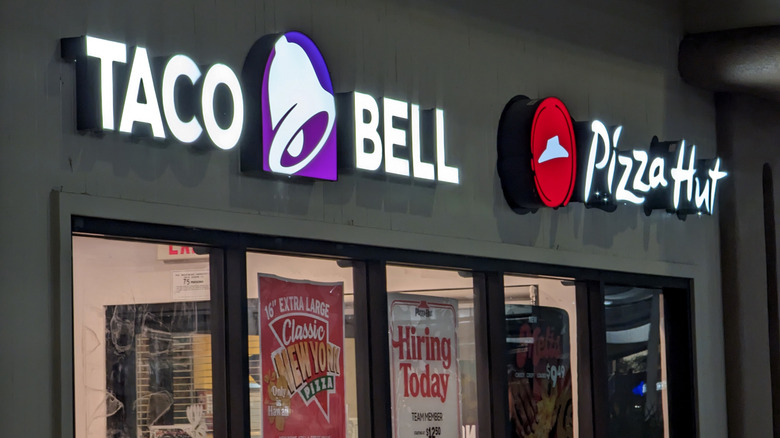What Happened To Those Taco Bell/Pizza Hut Combo Restaurants?
Combination Pizza Huts and Taco Bells have been an internet joke for seemingly as long as modern memory. But honestly, there's a good reason the online community has been tickled pink by the idea of Pizza Hut/Taco Bell combination restaurants since their inception in the early-to-mid 2000s: It's a fundamentally silly concept. Two wildly disparate restaurants, all under one roof? It felt at the time like it couldn't — or shouldn't — be real.
Today, it more or less isn't. If you're thinking about it and realizing you haven't seen any Pizza Hut/Taco Bell combinations lately, that's not just your imagination: Starting in the 2010s, these began vanishing. It's not entirely clear how many remain (especially since most people seem content to just repeat the meme to each other in online forums), but the ones that do are becoming increasingly lonely. If you're wondering why, we don't know with 100% certainty, but we can make some guesses. Regardless, it seems the brands tended to sink each other — or at least customers perceived that to be the case — and Yum! Brands ultimately decided each was better off flying solo.
The idea was for the combo locations to save the company money
Even if Pizza Hut did once feature the now-discontinued Fiesta Taco Pizza, the idea of taking two steps to the left from the Pizza Hut counter and grabbing a cheesy gordita crunch seems like a fever dream — but it was a fever dream for which Yum! Brands once pushed all its chips to the center of the table. Yum! Brands is one of the giants of fast food; it owns Taco Bell, Pizza Hut, KFC, and The Habit Burger Grill (and is the former owner of Long John Silver's and A&W Restaurants). For a while, it was the world's largest restaurant company when you combined all of its franchises. That's why if you see Pizza Hut and Taco Bell feuding online, it's pure showmanship; all the profit ultimately travels down the river to the same sea.
Given that several companies were possessed of one master, you can see the thinking that must have led to the combo restaurants: The profit of multiple brands but the overhead of one location's operating costs, at least as far as something like rent. But while it had its moment in the sun, that sun has set. Eventually, Yum! Brands began transitioning combo restaurants that clearly weren't working into solo ones or simply closing them outright. The company has never issued a specific rationale for doing so, but we can make some educated guesses.
Customers just didn't seem to want them
Again, a lot of this is guesswork, but we can assume they weren't making money (or that one half was making money while the other wasn't); there's no other obvious reason for Yum! Brands to pull the plug on them. But why weren't they profitable? It seems a fair bet that customer perception was a huge part of this. True or not, there was a perception of sanitation issues in the combo restaurants (and at least one, in New York City's Penn Station, actually was shut down by the health department). It's likewise unclear if the food itself at either or both halves of the combo restaurants suffered for their pairing, but it doesn't really matter if it's accurate if people believe it. If a restaurant's customers won't show up because they think the food is going to be bad, the restaurant isn't going to make money regardless.
Yum! Brands may have shut down many combo locations, but its fortunes weren't sunk by these closures. As recently as late 2022, the company planned to add at least 100,000 locations to its global roster of various brands. They'll just be separate locations, though, as the days of "Kentacohuts" are behind us.


